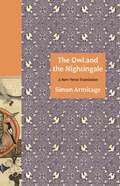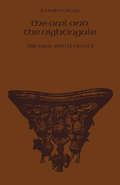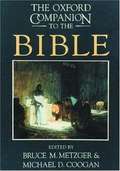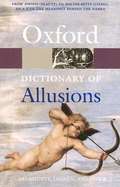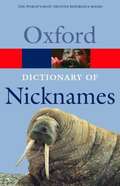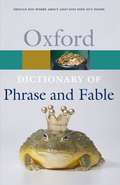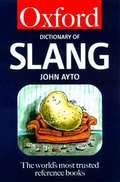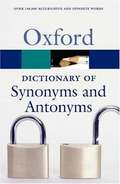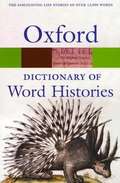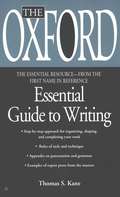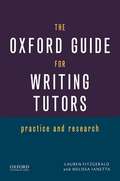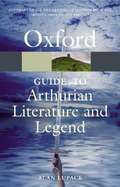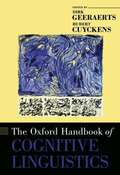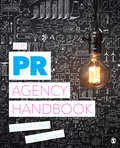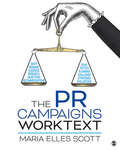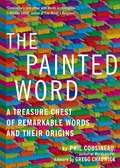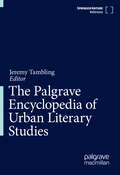- Table View
- List View
The Ovidian Vogue
by Daniel D. MossThe Roman poet Ovid was one of the most-imitated classical writers of the Elizabethan age and a touchstone for generations of English writers. In The Ovidian Vogue, Daniel Moss argues that poets appropriated Ovid not just to connect with the ancient past but also to communicate and compete within late Elizabethan literary culture.Moss explains how in the 1590s rising stars like Thomas Nashe and William Shakespeare adopted Ovidian language to introduce themselves to patrons and rivals, while established figures like Edmund Spenser and Michael Drayton alluded to Ovid's works as a way to map their own poetic development. Even poets such as George Chapman, John Donne, and Ben Jonson, whose early work pointedly abandoned Ovid as cliché, could not escape his influence. Moss's research exposes the literary impulses at work in the flourishing of poetry that grappled with Ovid's cultural authority.
The Owl and the Nightingale: A New Verse Translation (The Lockert Library of Poetry in Translation #134)
by Simon ArmitageFrom the UK Poet Laureate and bestselling translator of Sir Gawain and the Green Knight, a complete verse translation of a spirited and humorous medieval English poemThe Owl and the Nightingale, one of the earliest literary works in Middle English, is a lively, anonymous comic poem about two birds who embark on a war of words in a wood, with a nearby poet reporting their argument in rhyming couplets, line by line and blow by blow. In this engaging and energetic verse translation, Simon Armitage captures the verve and humor of this dramatic tale with all the cut and thrust of the original.In an agile iambic tetrameter that skillfully amplifies the prosody and rhythm of the original, Armitage’s translation moves entertainingly from the eloquent and philosophical to the ribald and ridiculous. Sounding at times like antagonists in a Twitter feud, the owl and the nightingale quarrel about a host of subjects that still resonate today—including love, marriage, identity, cultural background, class distinctions, and the right to be heard. Adding to the playful, raucous mood of the barb-trading birds is Armitage, who at one point inserts himself into the poem as a “magistrate . . . to adjudicate”—one who is “skilled with words & worldly wise / & frowns on every form of vice.”Featuring the Middle English text on facing pages and an introduction by Armitage, this volume will delight readers of all ages.
The Owl and the Nightingale: The Poems and Its Critics
by Kathryn HumeThe Owl and the Nightingale is clearly one of the few major Middle English poems. Despite the clarity and simplicity of its text, however, the poem has occasioned bitter and still unresolved interpretative controversy. Is the key to its meaning to be found in bird lore? the debate form? Is the poem a political or religious allegory? Despite the radical contradictions in the conclusions of previous critics, most of them have implicitly claimed a unique and exclusive validity. Kathryn Hume's purpose in writing this book is to offer a new account of the poem, one based on a systematic attempt to assess the validity and usefulness of various possible approaches to the work. She shows saneness, balance, and humour both in her criticism of previous interpretations and in her own conclusions. We need, she insists, to understand the nature of the poem before we erect elaborate theories about its meaning. The contradictoriness of the relevant avian traditions, the birds' complete incompetence as debaters, the poem's curiously indeterminate ending, and the critics' inability to agree even on the subject of the controversy, she argues, makes it difficult to see the work as a serious debate about anything. Attempts to find an extrinsic or allegorical meaning have proven radically contradictory and have all neglected large portions of the poem. But since no serious issue is present in the bird's dialogue, the meaning of the poem must indeed be sought elsewhere. Analysis of The Owl and the Nightingale's sequential impact and its manipulation of audience response emphasize the debate's lack of direction, its bitterness, and also – from the reader's point of view – its humour. Kathryn Hume argues that a great deal is clarified and made comprehensible if we regard the poem as a burlesque-satire on human contentiousness. The birds' illogic, the wandering arguments, the unsystematic introduction of various human concerns, and the inconclusive ending are all consistent with the idea that the poem was written as a witty caricature of petty but vicious human quarrelling. Both for its sane reinterpretation of what is widely considered one of the masterpieces of Middle English literature and for the interpretative methodology it employs, The Owl and the Nightingle: The Poem and Its Critics should be of lasting value to medievalists.
The Oxford Companion to American Literature
by James D. HartDesigned for students, this volume provides ready references to the authors and writings, past and present, that are included in the area of American literature.
The Oxford Companion to the Bible
by Michael D. Coogan Bruce M. MetzgerAn authoritative reference for key persons, places, events, concepts, institutions and realities of biblical times, this book also provides discussions on these topics by modern scholars.
The Oxford Dictionary of Allusions (2nd edition)
by Andrew Delahunty Penny Stock Sheila DignenAllusions form a colourful extension to the English language, drawing on our collective knowledge of literature, mythology, and religion to give us a literary shorthand for describing people, places, and events. So a miser is a Scrooge, a strong man is a Samson or a Hercules, a beautiful woman is a Venus or a modern-day Helen of Troy - we can suffer like Sisyphus, fail like Canute, or linger like the smile of the Cheshire Cat. This absorbing reference work explains the meanings of allusions in modern English, from Abaddon to Zorro, Tartarus to Tarzan, and Rubens to Rambo. Fascinating to browse through, the book is based on an extensive reading programme that has identified the most commonly-used allusions. Quotations are included in most entries to illustrate usage, from a range of authors and sources, from Thomas Hardy to Ben Elton, Charles Dickens to Bridget Jones's Diary. For this new second edition the most up-to-date allusions from Gollum to Kofi Annan have been added, and a handy A-Z order has been adopted for extra ease of reference.
The Oxford Dictionary of Nicknames
by Andrew DelahuntyThis reference for the general reader contains concise explanations of the origins of over 1,800 nicknames from contemporary and historical culture. They refer to historical figures, politicians, athletes, entertainers, places, events, and organizations and include, for example, "The Gipper" (Ronald Reagan), "The Virgin Queen" (Elizabeth I), "Satchmo" (Louis Armstrong), and "The Garden State" (New Jersey). The volume also features listings of the nicknames of British football clubs and army regiments as well as those for US Army infantry divisions. Annotation ©2004 Book News, Inc., Portland, OR (booknews.com)
The Oxford Dictionary of Phrase and Fable (2nd edition)
by Elizabeth KnowlesRevised and enlarged from the 2000 first edition, the dictionary cites words, phrases, and names with cultural resonance, to allow readers to understand and sometimes decode phrases they run across or perhaps have heard for years without ever quite understanding the connotation. The emphasis is on the allusion or reference, though origins of the phrase are also often explained. New here are such terms as nine-eleven (9-11, 9/11), axis of evil, and coalition of the willing. The cross-referencing is extensive. Annotation ©2006 Book News, Inc., Portland, OR (booknews.com)
The Oxford Dictionary of Slang
by John AytoA dictionary of common English slang terms and the estimated date of their appearance in the English language.
The Oxford Dictionary of Synonyms and Antonyms
by Oxford University PressAuthoritative, accessible, and completely up to date, this new edition of the popular Oxford Dictionary of Synonyms and Antonyms is an invaluable guide for anyone wanting to build their vocabulary and invigorate their writing skills. Over 140,000 alternative and opposite words are given with the closest, most frequently used synonyms listed first. In addition, thousands of real-life examples of usage from the Oxford English Corpus put the words in the context of sentences, which helps the reader to pinpoint the right word quickly and easily (and avoid embarrassing mistakes). Also included are some useful appendices designed to improve your knowledge of the language: a new Wordfinder section offers a selection of thematic lists--from chemical elements and clothing to phobias and flowers--and a Common Confusables supplement highlights the crucial differences between similar words that are often mixed up. Anyone wanting a practical and accessible language guide that will expand their vocabulary and sharpen their writing skills--including families, word game buffs, and students learning English as a foreign language--will want this dictionary on their reference shelf.
The Oxford Dictionary of Word Histories
by Glynnis ChantrellThe Oxford Dictionary of Word Histories describes the origins and sense development of over 11,000 words in the English language. Well-known idioms such as "say it with flowers" are highlighted with the dates of their original use and how and when they came about. Colorful popular beliefs are explored about the origins of words like "posh" and "snob," and insights are given into our social history revealed by language development such as the connection in a Roman soldier's mind of "salary" with salt. Throughout, boxed word-building elements show the various meanings of shared "relationships" between words.
The Oxford Essential Guide to Writing
by Thomas S. KaneWhether you’re composing a letter, writing a school thesis, or starting a novel, this resource offers expert advice on how to think more creatively, how to conjure up ideas from scratch, and how to express those ideas clearly and elegantly.
The Oxford Guide for Writing Tutors: Practice and Research
by Melissa Ianetta Lauren FitzgeraldThe Oxford Guide for Writing Tutors introduces two conversations to the tutor's preperation, one about the creation of knowledge in writing programs, the other about tutor research. This approach to tutor training provides several benefits. First, it allows tutors to test their theories of what might work in a writing center session and helps them to move professional conversation towards why such things happen. They bridge the theory-practice divide that often frustrates both novices and experiences tutors. By conducting research to answer such questions, tutors can help themselves, the writers with whom they work, their fellow tutors - and the writers with whom they work. And, further, this approach gives the reader new methods for appreciating and critiquing scholarly work, making it easier to understand the best ways to help writers and to move the field forward. As writing tutoring programs take on a variety of forms and pursue a range of missions, this book aims to create a flexible text whose contents can be easily rearranged to support a broad spectrum of reader needs. Each chapter, accordingly, can be read independently; the text does not rely on a sequential reading to create meaning. The book also includes intra-textual and extra-textual references for the reader who wants to inquire further. That is, throughout the book are references to material in other chapters that might be of interest to the reader intrigued by the topic at hand. So too, in each chapter, we include references to and citations of the scholarship that supports much of the "common knowledge" of the field, including, in the Handbook, both previous tutor education textbooks and research from the field. The aim is to aid the interested reader's inquiry into the scholarship of the field as well as to ground advice about practice in research that testifies to the effectiveness a range of tutoring practices. Much of the scholarship cited throughout the book is authored by undergraduate tutor-researchers as well as several former tutors who were graduate students when they published their articles. This crucial aspect best models the ways in which tutors themselves can bring together practice and research, in their day-to-day work and in their informed thinking about this work. Including tutor voices is an important tradition of the tutor education textbook because these are voices that speak to the issues concerning tutors in a range of institutions and programs across the country.
The Oxford Guide to Arthurian Literature and Legend
by Alan LupackThe Oxford Guide to Arthurian Literature and Legend is both a critical history of the Arthurian tradition and a reference guide to Arthurian works, names, and symbols. It offers a comprehensive survey of the legends in all of their manifestations, from their origins in medieval literature to their adaptation in modern literature, arts, film, and popular culture. Not only does it analyse familiar Arthurian characters and themes, it also demonstrates the tremendous continuity of the legends by examining the ways that they have been reinterpreted over the years. For instance, the motif of the abduction of Guinevere can be traced from Chretien de Troyes's Lancelot or the Knight of the Cart and the vulgate cycle of French romances in the 13th century, to Malory's retelling of the story in the Morte d'Arthur, through various modern adaptations like those in T. H. White's The Once and Future King and the contemporary film First Knight. This indispensable reference guide contains seven essays that trace the development of the Arthurian legend, encyclopedic entries, bibliographies, and a comprehensive index. The essays explore the chronicle and romance traditions, the influence of Malory, the Grail legend, the figures of Gawain and Merlin, and the story of Tristan and Isolt. The entries, which highlight key Arthurian characters, symbols, and places, offer quick and easy references. The extensive chapter-by-chapter bibliographies, which are subdivided by topic, augment the general bibliography of Arthurian resources. Comprehensive in its analysis and hypertextual in its approach, The Oxford Guide to Arthurian Literature and Legend is an essential reference book for Arthurian scholars, medievalists, and for those interested in cultural studies of myth and legend.
The Oxford Guide to Word Games
by Tony Augarde A. J. AugardeRiddles such as this are just one of the forms of linguistic gymnastics explored in this invaluable source-book. Unique in its thematic and historical approach to the subject, it will tell you everything you ever wanted to know about word games and wordplay, and is entertaining as well as informative. The Oxford Guide to Word Games quickly established itself as the authoritative work on the subject when it was first published in 1984. It not only described all the major word games but also traced their origins and placed them in their social context. Now thoroughly revised, enlarged, and updated to make it even more valuable and comprehensive, this edition includes several new chapters, covering topics such as homonyms and slips of the tongue. New material has also been added on many topics including crossword clues, blends, and kangaroo words. Book jacket.
The Oxford Handbook of Cognitive Linguistics
by Dirk Geeraerts Hubert CuyckensThe Oxford Handbook of Cognitive Linguistics presents a comprehensive overview of the main theoretical concepts and descriptive/theoretical models of Cognitive Linguistics, and covers its various subfields, theoretical as well as applied. The first twenty chapters give readers the opportunity to acquire a thorough knowledge of the fundamental analytic concepts and descriptive models of Cognitive Linguistics and their background. The book starts with a set of chapters discussing different conceptual phenomena that are recognized askey concepts in Cognitive Linguistics: prototypicality, metaphor, metonymy, embodiment, perspectivization, mental spaces, etc. A second set of chapters deals with Cognitive Grammar, Construction Grammar, and Word Grammar, which, each in their own way, bring together the basic concepts into aparticular theory of grammar and a specific model for the description of grammatical phenomena. Special attention is given to the interrelation between Cognitive and Construction Grammar. A third set of chapters compares Cognitive Linguistics with other forms of linguistic research (functionallinguistics, autonomous linguistics, and the history of linguistics), thus giving a readers a better grip on the position of Cognitive Linguistics within the landscape of linguistics at large. The remaining chapters apply these basic notions to various more specific linguistic domains, illustrating how Cognitive Linguistics deals with the traditional linguistic subdomains (phonology, morphology, lexicon, syntax, text and discourse), and demonstrating how it handles linguistic variationand change. Finally they consider its importance in the domain of Applied Linguistics, and look at interdisciplinary links with research fields such as philosophy and psychology. With a well-known cast of contributors from around the world, this reference work will be of interest to researchers and advanced students in (cognitive) linguistics, psychology, cognitive science, and anthropology.
The Oxford Reader: Varieties of Contemporary Discourse
by Frank Kermode Richard PoirierSelected essays on topics of interest to traditional College students.
The PR Agency Handbook
by Regina M. Luttrell Luke W. CapizzoA Practical and Concise Introduction to Agency Life The PR Agency Handbook guides students through the day-to-day operations of a professional PR agency and offers best practices for creating a successful career in the industry. Authors Regina Luttrell and Luke Capizzo highlight real-world stories from the field as well as interviews with PR experts to help students bridge the gap between college and professional life. Throughout the book, students are introduced to many of the sub-fields of strategic communication, including traditional public relations and corporate communication, marketing, social media, creative production (print, digital, video, audio), web and user experience design, and search engine optimization (SEO). Students will not only develop a fundamental understanding of the different components found within an agency, but they will also gain an appreciation for the positive impact that excellent agency work can have on organizations.
The PR Agency Handbook
by Regina M. Luttrell Luke W. CapizzoA Practical and Concise Introduction to Agency Life The PR Agency Handbook guides students through the day-to-day operations of a professional PR agency and offers best practices for creating a successful career in the industry. Authors Regina Luttrell and Luke Capizzo highlight real-world stories from the field as well as interviews with PR experts to help students bridge the gap between college and professional life. Throughout the book, students are introduced to many of the sub-fields of strategic communication, including traditional public relations and corporate communication, marketing, social media, creative production (print, digital, video, audio), web and user experience design, and search engine optimization (SEO). Students will not only develop a fundamental understanding of the different components found within an agency, but they will also gain an appreciation for the positive impact that excellent agency work can have on organizations.
The PR Campaigns Worktext
by Maria Elles ScottWhy just read about creating a PR campaign when you can actually create a campaign yourself as you learn? By combining coverage of fundamental PR campaign concepts with the classic design of a workbook, The PR Campaigns Worktext by Maria Scott walks students through building their own PR campaigns. Unlike other campaigns texts, this worktext lays out concepts, applications, and examples in campaign building, and then ask students to complete worksheets with focused tasks so students have all the tools and direction to create and customize their specific campaign. This approach helps students think about their client’s needs, and guides students through building the campaign part by part. In combining the readings with prompts to complete worksheets, this book will serve as a student’s trusted resource as they take their first steps into the world of PR.
The PR Campaigns Worktext
by Maria Elles ScottWhy just read about creating a PR campaign when you can actually create a campaign yourself as you learn? By combining coverage of fundamental PR campaign concepts with the classic design of a workbook, The PR Campaigns Worktext by Maria Scott walks students through building their own PR campaigns. Unlike other campaigns texts, this worktext lays out concepts, applications, and examples in campaign building, and then ask students to complete worksheets with focused tasks so students have all the tools and direction to create and customize their specific campaign. This approach helps students think about their client’s needs, and guides students through building the campaign part by part. In combining the readings with prompts to complete worksheets, this book will serve as a student’s trusted resource as they take their first steps into the world of PR.
The Painted Word
by Phil CousineauTo untangle the knot of interlocking meanings of these painted words, logophile and mythologist Phil Cousineau begins each fascinating word entry with his own brief definition. He then fills it in with a tint of etymology and a smattering of quotes that show how the word is used, ending with a list of companion words. The words themselves range from commonplace - like biscuit, a twice-baked cake for Roman soldiers - to loanwords including chaparral, from the Basque shepherds who came to the American West; words from myths, such as hector; metamorphosis words, like silly, which evolved holy to goofy in a mere thousand years; and words well worthy of revival, such as carrytale, a wandering storyteller. Whether old-fangled or brand new, all the words included in The Painted Word possess an ineffable quality that makes them luminous.
The Painted Word: A Treasure Chest of Remarkable Words and Their Origins
by Phil CousineauTo untangle the knot of interlocking meanings of these painted words, logophile and mythologist Phil Cousineau begins each fascinating word entry with his own brief definition. He then fills it in with a tint of etymology and a smattering of quotes that show how the word is used, ending with a list of companion words. The words themselves range from commonplace -- like biscuit, a twice-baked cake for Roman soldiers -- to loanwords including chaparral, from the Basque shepherds who came to the American West; words from myths, such as hector; metamorphosis words, like silly, which evolved holy to goofy in a mere thousand years; and words well worthy of revival, such as carrytale, a wandering storyteller. Whether old-fangled or brand new, all the words included in The Painted Word possess an ineffable quality that makes them luminous.
The Palestinian Novel
by Abu-Manneh BashirWhat happens to the Palestinian novel after the national dispossession of the nakba, and how do Palestinian novelists respond to this massive crisis? This is the first study in English to chart the development of the Palestinian novel in exile and under occupation from 1948 onwards. By reading the novel in the context of the ebb and flow of Arab and Palestinian revolution, Bashir Abu-Manneh defines the links between aesthetics and politics. Combining historical analysis with textual readings of key novels by Jabra, Kanafani, Habiby, and Khalifeh, the chronicle of the Palestinian novel unfolds as one that articulates humanism, self-sacrifice as collective redemption, mutuality, and self-realization. Political challenge, hope, and possibility are followed by the decay of collective and individual agency. Genet's and Khoury's unrivalled literary homages to Palestinian revolt are also examined. By critically engaging with Lukács, Adorno, and postcolonial theory, questions of struggle and self-determination take centre stage.
The Palgrave Encyclopedia of Urban Literary Studies
by Jeremy TamblingThis encyclopaedia will be an indispensable resource and recourse for all who are thinking about cities and the urban, and the relation of cities to literature, and to ways of writing about cities. Covering a vast terrain, this work will include entries on theorists, individual writers, individual cities, countries, cities in relation to the arts, film and music, urban space, pre/early and modern cities, concepts and movements and definitions amongst others. Written by an international team of contributors, this will be the first resource of its kind to pull together such a comprehensive overview of the field.

